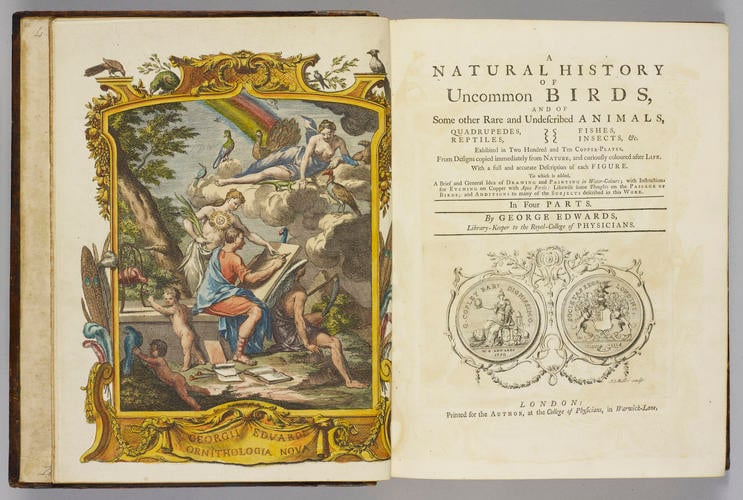-
1 of 253523 objects
A Natural history of uncommon birds and of some other rare and undescribed animals 1743
RCIN 1057008

George Edwards (1694-1773)
A Natural history of uncommon birds and of some other rare and undescribed animals. . . in four parts ; pts 1 and 2 / by George Edwards 1743

George Edwards (1694-1773)
A Natural history of uncommon birds and of some other rare and undescribed animals. . . in four parts ; pts 1 and 2 / by George Edwards 1743


-
Edwards began studying natural history, especially birds, after an unsuccessful career as a businessman, ‘applying himself to drawing and colouring such animals as fell under his notice’, including foreign specimens brought into the Port of London by ship. Edwards’ chief aim was to ‘achieve a natural and accurate portrayal’, though often from stuffed specimens; with no clear idea of suitable backgrounds he would perch smaller birds on a lichen-covered branch, or give them a general backdrop of water (for the water birds) or vegetation. His work drew many admirers from the rich and learned but his chief patron was Sir Hans Sloane. Edwards was a naturalist as well as an artist, and thus tried to depict birds as accurately as possible, unlike some of his predecessors. He was taught to etch by Mark Catesby, and produced his own plates for publication, which he then coloured personally or supervised others at the work, in order to preserve colour accuracy:
'I do not purpose to part with any of the Prints uncolour’d while I live, lest they should be afterwards colour’d by unskilful People …. A Copy carefully and exactly colour’d from the original Drawings, will be deposited in the Library of the College of Physicians … which may serve as a Standard to refer to and compare with … in case the Plates should outlive me.'
This copy includes an engraved frontispiece entitled Ornithologia nova, a tribute to Francis Willughby’s Ornithologia (1676). It also includes the title page of 1751, showing the Copley Medal, awarded to Edwards by the Royal Society in 1750. This medal, instigated in 1731, is the oldest and most prestigious award of the Royal Society for outstanding achievement in the physical and biological sciences.Provenance
Probably the copy listed in the inventory of George III’s library at Richmond Lodge, prior to its dispersal c. 1766. In George III's Windsor library by 1780.
-
Creator(s)
(publisher)Acquirer(s)
-
Alternative title(s)
A Natural history of uncommon birds and of some other rare and undescribed animals... in four parts ; pts 1 and 2 / by George Edwards.